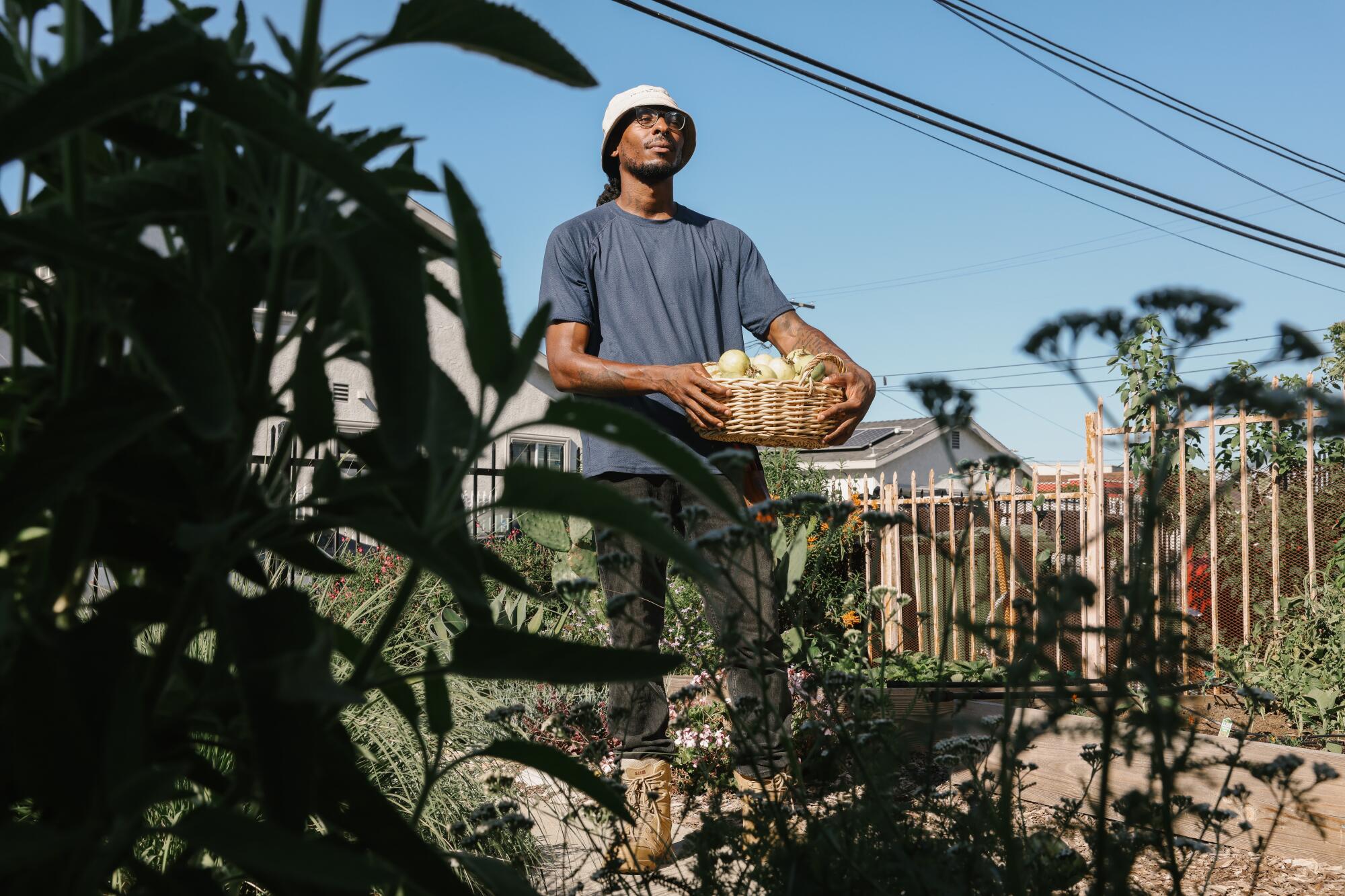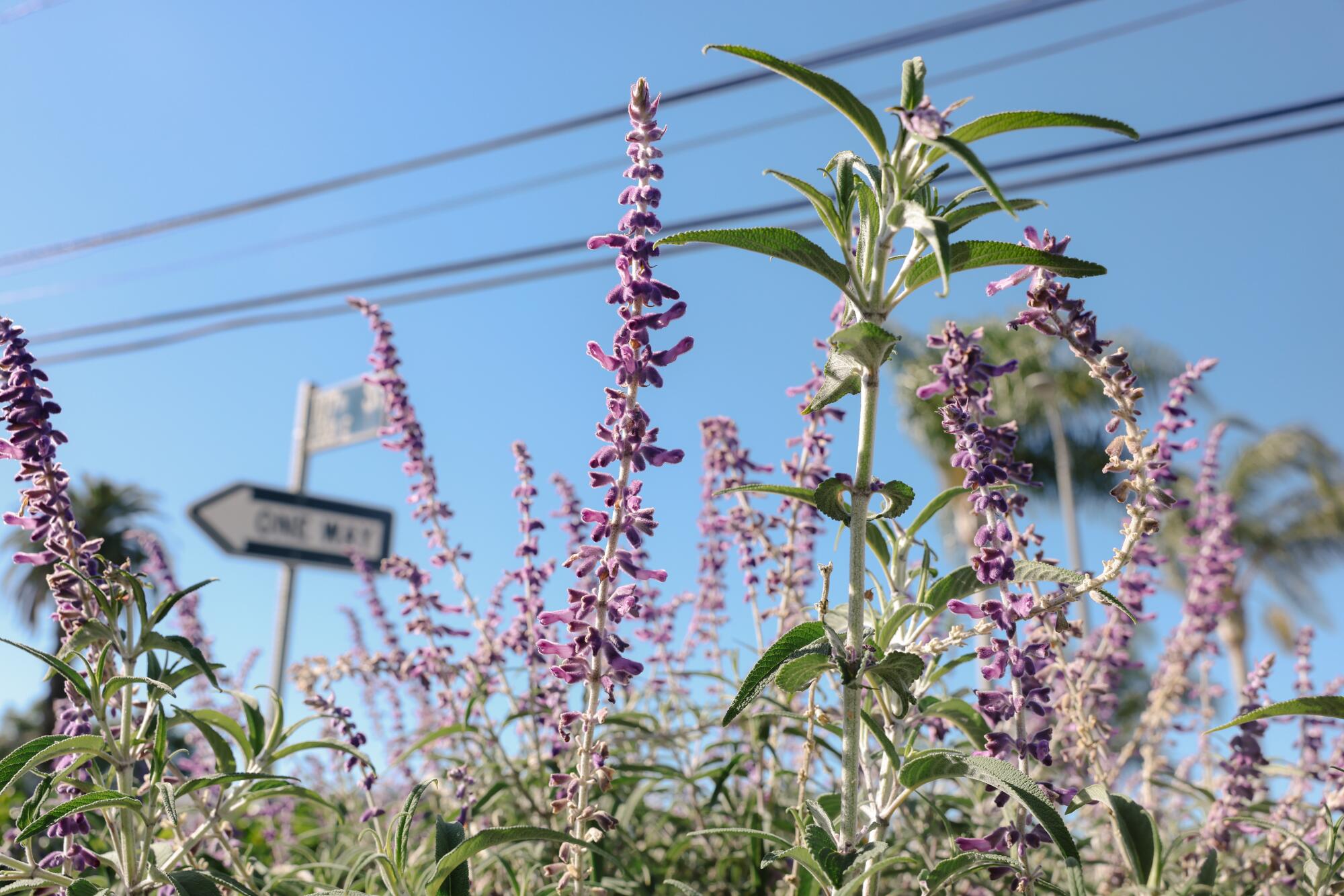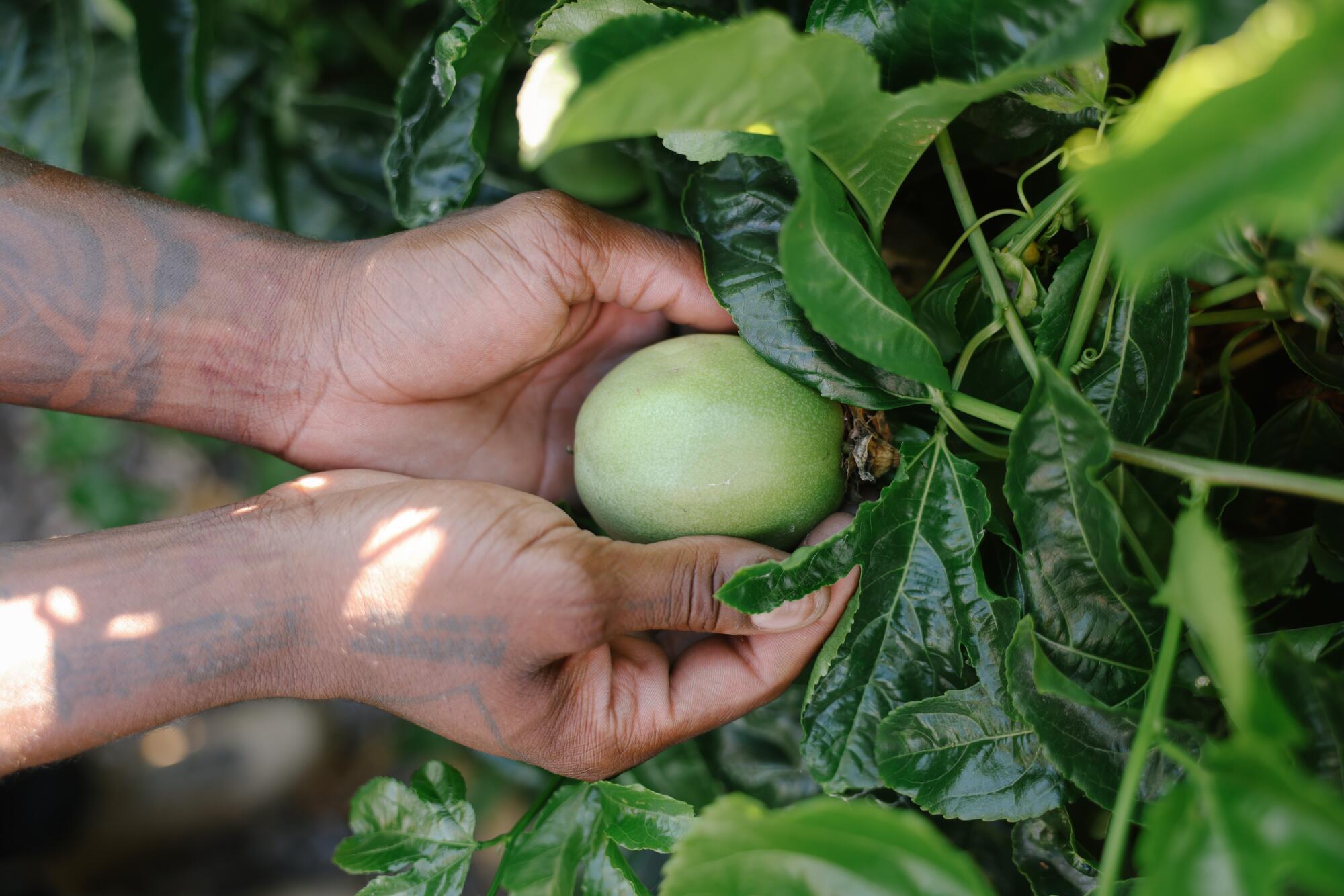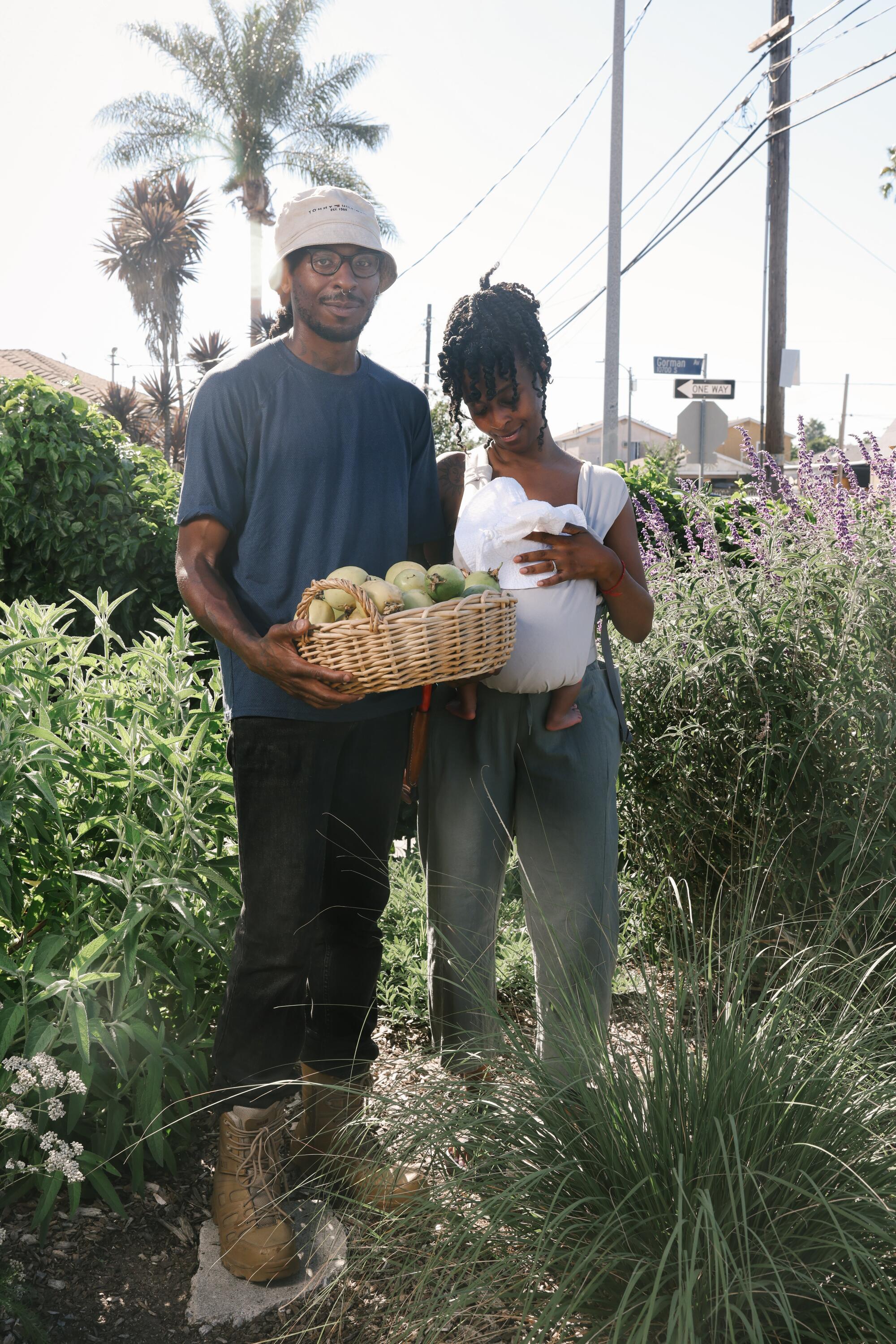
Water-hungry lawns are symbols of Los Angeles’ past. In this series, we spotlight yards with alternative, low-water landscaping built for the future.
Even in his early years, Stephen Reid knew he was destined to work and inspire with plants.
Today, Reid, 35, is the assistant curator and head gardener of the rose garden at the Huntington Library, Art Gallery and Botanical Gardens, a job he achieved after years of DIY studies, garden volunteer work and multiple plant and gardening certifications.

Yarrow grows in Stephen Reid’s front yard where he used the LADWP turf replacement program to transform it into a native and drought-tolerant habitat. (Dania Maxwell / Los Angeles Times)

Ashley Reid stands for a portrait with her newborn Phoenix in the yard she and her husband transformed. (Dania Maxwell / Los Angeles Times)

He’s earned certificates as an organic gardener through Grow L.A. Gardens courses, a UC Cooperative Extension master gardener and a California native plant landscaper, skills he’s honed outside the fixer-upper home he and his wife Ashley bought in Watts.
Together they dug out the weedy 940-square-foot front lawn and parkway by themselves, shoveled in mountains of composted horse manure and wood-chip mulch and relandscaped — twice! — with drought-tolerant and native plants, herbs, vegetables and a passion fruit vine so massive and productive that it supplies half the neighborhood with fruit.
Los Angeles County residents have been removing their lawns to save money and water during the megadrought.
They also rebuilt their DJ business For the Culture Sound in L.A., and started a family: Their daughter, Phoenix, was born July 29, just four months after Reid started his new job at the Huntington. It’s a busy life — “We learned to live with two to three hours of sleep” — but Reid said he feels “kind of blessed every day.”
The Huntington typically hires people with botanical degrees, he said, “but I took an alternate route with lots of certifications and it worked for me. It was kind of an intersection of luck, hard work and passion.”
Reid was born in Toronto to a mother from Trinidad & Tobago and a father from Barbados. They separated when he was 5, and he moved back and forth between their homes in Toronto and Alabama.


Plants were never a priority in either household. His parents believed “if I wasn’t a doctor or a lawyer, I would be a failure,” he said, “but growing up, my mom affectionately called me ‘Dirt’ because I was always trailing dirt into the house. I loved to carry around plants and bugs, and have my feet in the dirt.”
He left college in Florida before finishing his degree to help a friend develop a clothing line in Los Angeles. That led to advertising work in New York, where he met and married Ashley, a Brooklyn native and partner in their new DJ business. Things were going well personally and professionally, but something was missing.
“The corporate advertising world was where I was making my money,” he said, “but I remember taking extended lunch breaks near a river park and laying in the grass just trying to see how things grow. That underlying resonance (for plants) was there; I just wasn’t sure how to explore it.”
Eventually, the couple left their day jobs to run the DJ business full-time. But Reid kept coming back to plants. His frequent visits to the Brooklyn Botanic Garden turned into volunteer sessions there. He joined the Brooklyn Urban Gardeners training program for fledgling gardeners and started a guerrilla garden of herbs and lettuce in old cinder blocks behind his apartment. When COVID shut down their DJ work in 2020, he became a paid apprentice at Flower Power Herbs, a popular herb shop in Manhattan’s East Village.

About two-thirds of the way through his 1,000-hour herbalist training, Stephen and Ashley decided they were done with New York: “We were craving sun and space to get out in nature without a two-hour train ride.”
So in early 2021 they began a long-distance house hunt. They found a 956-square-foot fixer-upper in Watts with a small, patchy lawn in the front yard and a big backyard covered with concrete. Reid finished his apprenticeship and earned his herbalist certificate the same month they left New York.
They used an FHA program that allowed just a 5% down payment, and felt lucky to get the house after the first and second buyers had to drop out.
Their first priority was making their new house habitable. That took about six months on a shoestring budget.
Situated behind grandma’s house, this Eagle Rock ADU is perfect for a young family of three.
Then Reid turned his attention to the yard. He pursued a rumor he’d heard about the Los Angeles Department of Water & Power‘s turf replacement program, which then paid residents $3 a square foot (it’s $5 per square foot now) to tear out their lawns and relandscape with drought-tolerant plants, mulch and a rain-capturing feature like a bioswale or rain barrel.
Before he applied, he signed up for several weeks of LADWP’s free Landscape Training Classes to learn how to submit a successful application as well as the basics of rainwater harvesting, efficient irrigation, landscaping with native plants and garden design. Thus armed, he used his Adobe Illustrator skills from his advertising days to put together a small map of his yard and a landscape plan. His application was approved.
That’s when the real work began, he said. He and Ashley rented a sod-cutting machine to cut out their old lawn in long, heavy strips. The city had stopped delivering mulch during the pandemic, so they found a source on Craigslist (Joel Griffith of the Imperial Equestrian Center in South Gate) selling bulk composted horse manure, wood-chip mulch and soil.

Griffith delivered the amendments in towering hills in the road next to their home. They got to work immediately, because they had a deadline: “I had to get it off the street so people could park the next day,” he said.
“We bought a lot of pizza and beer and invited all our friends to help,” he said. They laid painters paper over the old lawn to smother any remaining weeds, then covered the yard with the composted horse manure the first day, topped by the mulch on day two.
His friends stayed until the evening. They didn’t have a wheelbarrow, something Reid sorely regretted because it made moving the piles much more difficult. Ashley kept shoveling a few hours more, but finally it was just Stephen, moving mulch until 2 a.m.
Our L.A. Plants newsletter
Doing most of the work themselves saved money for more important things. His rebate was around $2,900, he said, which more than covered expenses for materials and plants.
They added a swale filled with rocks to collect rainwater and then planted on a wing and a prayer, Reid said, guessing at the best location for the plants they acquired, including English and French lavenders, several sage varieties and medicinal herbs like rue, calendula and lion’s tale, which is a popular tea for stomach ailments in Trinidad.

A few months later, Reid decided to build two 4-by-4-foot raised beds for the sunniest section of his front yard. He planted vegetables and herbs from seeds, along with free plugs — small starts — of pollinator-friendly flowers like zinnias from nearby Mud Town Farms.
Things got really busy in early 2022. He got a gardening job at South Coast Botanic Garden. He was accepted into Los Angeles County’s Master Gardener program and he got a slot in Theodore Payne Foundation’s Native Plant Landscaper Certificate Program. “Sleeping really wasn’t a thing,” he said, laughing.
Reid figures those new certifications and his work at South Coast Botanic Garden are what helped him land his dream job at the Huntington this spring, along with his past experiences in New York organizing volunteers to work at the Brooklyn Botanic Garden.

But Reid also credits his decision to spend most of his time working in South Coast Botanic Garden’s sunny rose garden. “Nobody wanted to work in the rose garden because it has no shade,” he said. “I went in specifically knowing I wanted to work in the rose garden because I have always loved roses.”
He said he’s grateful to Terry Huang, South Coast’s director of living collections, learning and engagement, for teaching him about rose care and varieties. He spent his lunches reading dusty rose-growing manuals in the garden’s work sheds and combing thrift stores for old rose guides. Now he’s learning under the tutelage of famed rose breeder Tom Carruth, the curator of the Huntington’s rose garden, and helping to organize the many volunteers clamoring to learn from the master too.
While these gardens are beautiful and inviting spaces, don’t mistake them for parks. They are more like living museums.
“I tend to get stuck in rabbit holes, and roses are my new rabbit hole,” Reid said. “I trained a new volunteer today who said he’d been looking forward to being a volunteer at the Huntington for 35 years, and he bought a house close to the Huntington so he could volunteer, which just blew me away. Working here is a really big blessing for me, and I am still trying to wrap my head around it.”
Having a yard to put all his horticulture lessons into practice helped accelerate his learning, he said. He basically replanted his front yard, this time adding many more native plants, this time with more confidence about where they should go. The yard is small but he still found space for a diverse and fragrant collection:
- Bee’s Bliss sage (Salvia x ‘Bee’s Bliss’)
- California fuchsia (Epilobium canum)
- Catalina cherry (Prunus ilicifolia ssp. lyonii)
- Common yarrow (Achillea millefolium)
- De La Mina verbena (Verbena lilacina ‘De La Mina’)
- Deergrass (Muhlenbergia rigens)
- Fingertips (a.k.a. Lady Fingers) (Dudleya edulis)
- Fragrant pitcher sage (Lepechinia fragrans)
- Island alum root (Heuchera maxima)
- Margarita BOP penstemon (Penstemon heterophyllus ‘Margarita BOP’)
- Mountain blue penstemon (Penstemon laetus)
- Mugwort (Artemisia douglasiana)
- Narrow leaf milkweed (Asclepias fascicularis)
- Redflower buckwheat (Eriogonum grande)
- Santa Ana Cardinal coral bells (Heuchera ‘Santa Ana Cardinal’)
- Yerba buena (Clinopodium douglasii)
It’s not all natives. Reid created a section near the porch for roses, where they can get lots of light and all the water they need without overwatering the rest of the yard. He bought his first rose — a highly fragrant purple-lavender variety called Perfume Factory — at AJ Nursery in Compton (ironically bred years ago by his future boss) and kept a few plants in the yard’s original landscape, such as a morning glory vine that wraps around the supports on the pocket-square porch, a few aloe plants and prickly pear cactus, in part because its leaves and fruit are popular with his Latino neighbors.


Most astonishing is the 3-foot-tall passion fruit he planted last year that has grown to more than 25 feet, providing privacy along the fence with its lush green vines and abundant fruit. Every day, Reid said, he fills a huge bowl with its sweet, citrus-flavored fruit, passing them out to whoever will take them. Most of his neighbors are Spanish speakers, he said, but sharing his fruit and other food from his garden has helped break the ice.
There have been trials as well. Gophers devoured many of his early plants, including his lavenders. He’s tried a variety of methods to keep them out of the yard, including a device that sends vibrations into the ground every few minutes; so far it seems to be working. And for now, he’s given up trying to maintain the parkway outside his fence: Stray dogs have repeatedly dug and pooped there and people have walked over his garden area or stolen plants outright. The final blow was an 18-wheeler that drove over the curb and left all the remaining plants flattened.
But mostly, gardening outside his home has been a dream come true for Reid. He loves sharing what he’s learned, he said, along with the food he’s growing and even tiny plants he started from seed. There’s always something new to see in the yard — flowers blooming, hummingbirds darting about, a Mason jar of calendula oil baking in the sun — and people stop often to admire it and ask questions.
Taylor Lindsey connects L.A. to urban farming practices through the Plant Plug, her South Los Angeles nursery and garden. She also hosts monthly gardening workshops.
“A lot of people have lived here 15 to 20 years and never seen anything like this,” he said. “I want this to be a beacon, an example in the community of what’s possible, especially for Black and brown people. I give people tomatoes or strawberries so they can be inspired to garden on their own properties.”
Reid said he’s thought a lot about why he so rarely sees Black people, especially Black men, in the horticulture programs he’s taken. “I can only speak for myself as a Canadian Caribbean, not an African American, so I’m more like a voyeur looking in, but it seems like there are similarities between gardening and hiking — when we go backpacking you rarely see any Black people on the trail,” he said.

“I think a lot of that is because of the connection to the trauma of slavery; people had no choice but to work the land, and then people were intentionally left out of other opportunities, when only white men were allowed in the room. So that little trauma and lack of opportunity causes people to disassociate from the land, which is so unfortunate because there’s so much healing power that comes with anything you do with the land.”
Reid aims to do what he can to spread the word. He’s already been volunteering at Echo Park and some community gardens, weeding and mulching while he proselytizes about the curative power of growing your own food. “People are curious and I can show them there are multiple ways to learn in this field, by volunteering, going to school. ... There are so many opportunities to find your way into gardening.
“I know it sounds like hard work, but I generally don’t feel like I’m working too hard,” he said. “As my mom used to say, ‘Love what you do, and you won’t have to work a day in your life.’”
More to Read
It's a date
Get our L.A. Goes Out newsletter, with the week's best events, to help you explore and experience our city.
You may occasionally receive promotional content from the Los Angeles Times.













